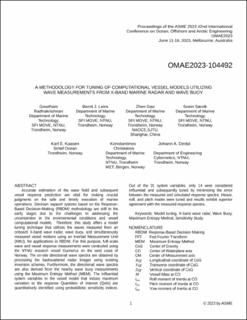| dc.contributor.author | Radhakrishnan, Gowtham | |
| dc.contributor.author | Leira, Bernt Johan | |
| dc.contributor.author | Gao, Zhen | |
| dc.contributor.author | Sævik, Svein | |
| dc.contributor.author | Kaasen, Karl Erik | |
| dc.contributor.author | Christakos, Konstantinos | |
| dc.contributor.author | Dirdal, Johann Alexander | |
| dc.date.accessioned | 2024-02-26T09:35:25Z | |
| dc.date.available | 2024-02-26T09:35:25Z | |
| dc.date.created | 2023-10-19T22:39:01Z | |
| dc.date.issued | 2023 | |
| dc.identifier.citation | ASME 2023 42nd International Conference on Ocean, Offshore and Arctic Engineering - Paper No: OMAE2023-104492, V002T02A010; 10 pages | en_US |
| dc.identifier.isbn | 978-0-7918-8687-8 | |
| dc.identifier.uri | https://hdl.handle.net/11250/3119840 | |
| dc.description.abstract | Accurate estimation of the wave field and subsequent vessel response prediction are vital for making crucial judgments on the safe and timely execution of marine operations. Decision support systems based on the Response-Based Decision-Making (RBDM) methodology are still in the early stages due to the challenges in addressing the uncertainties in the environmental conditions and vessel computational models. Therefore, this study offers a model tuning technique that utilizes the waves measured from an onboard X-band wave radar, wave buoy, and simultaneously measured vessel motions using an Inertial Measurement Unit (IMU), for applications in RBDM. For this purpose, full-scale wave and vessel response measurements were conducted using the NTNU research vessel Gunnerus on the west coast of Norway. The on-site directional wave spectra are obtained by processing the backscattered radar images using existing inversion schemes. Furthermore, the directional wave spectra are also derived from the nearby wave buoy measurements using the Maximum Entropy Method (MEM). The influential system variables in the vessel model that induce maximum variation to the response Quantities of Interest (QoIs) are quantitatively identified using probabilistic sensitivity indices. Out of the 31 system variables, only 14 were considered influential and subsequently tuned by minimizing the error between the measured and simulated response spectra. Heave, roll, and pitch modes were tuned and results exhibit superior agreement with the measured response spectra. | en_US |
| dc.language.iso | eng | en_US |
| dc.publisher | ASME | en_US |
| dc.relation.ispartof | ASME 2023 42nd International Conference on Ocean, Offshore and Arctic Engineering : Volume 5 : Ocean Engineering | |
| dc.relation.uri | https://asmedigitalcollection.asme.org/OMAE/proceedings/OMAE2023/86847/V002T02A010/1166956 | |
| dc.title | A Methodology for Tuning of Computational Vessel Models Utilizing Wave Measurements From X-Band Marine Radar and Wave Buoy | en_US |
| dc.title.alternative | A Methodology for Tuning of Computational Vessel Models Utilizing Wave Measurements From X-Band Marine Radar and Wave Buoy | en_US |
| dc.type | Chapter | en_US |
| dc.description.version | acceptedVersion | en_US |
| dc.identifier.doi | 10.1115/OMAE2023-104492 | |
| dc.identifier.cristin | 2186569 | |
| dc.relation.project | Norges forskningsråd: 237929 | en_US |
| cristin.ispublished | true | |
| cristin.fulltext | postprint | |
| cristin.qualitycode | 1 | |
